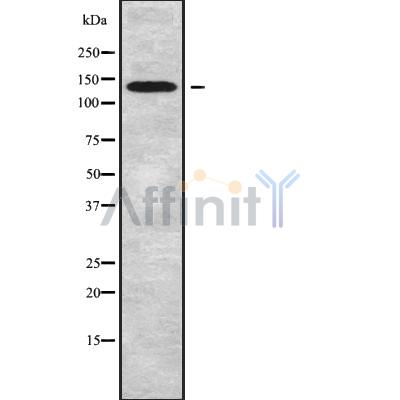ATP2B2 Antibody - #DF9757
| Product: | ATP2B2 Antibody |
| Catalog: | DF9757 |
| Description: | Rabbit polyclonal antibody to ATP2B2 |
| Application: | WB IHC IF/ICC |
| Reactivity: | Human, Rat |
| Prediction: | Bovine, Horse, Sheep, Rabbit, Dog |
| Mol.Wt.: | 137 kDa; 137kD(Calculated). |
| Uniprot: | Q01814 |
| RRID: | AB_2842952 |
Related Downloads
Protocols
Product Info
*The optimal dilutions should be determined by the end user. For optimal experimental results, antibody reuse is not recommended.
*Tips:
WB: For western blot detection of denatured protein samples. IHC: For immunohistochemical detection of paraffin sections (IHC-p) or frozen sections (IHC-f) of tissue samples. IF/ICC: For immunofluorescence detection of cell samples. ELISA(peptide): For ELISA detection of antigenic peptide.
Cite Format: Affinity Biosciences Cat# DF9757, RRID:AB_2842952.
Fold/Unfold
AT2B2_HUMAN; atp2b2; ATPase plasma membrane Ca2+ transporting 2; Plasma membrane calcium ATPase 2; Plasma membrane calcium ATPase; Plasma membrane calcium ATPase isoform 2; Plasma membrane calcium pump isoform 2; Plasma membrane calcium transporting ATPase 2; Plasma membrane calcium-transporting ATPase 2; PMCA2; PMCA2a; PMCA2i;
Immunogens
A synthesized peptide derived from human ATP2B2, corresponding to a region within N-terminal amino acids.
Mainly expressed in brain cortex. Found in low levels in skeletal muscle, heart muscle, stomach, liver, kidney and lung. Isoforms containing segment B are found in brain cortex and at low levels in other tissues. Isoforms containing segments X and W are found at low levels in all tissues. Isoforms containing segment A and segment Z are found at low levels in skeletal muscle and heart muscle.
- Q01814 AT2B2_HUMAN:
- Protein BLAST With
- NCBI/
- ExPASy/
- Uniprot
MGDMTNSDFYSKNQRNESSHGGEFGCTMEELRSLMELRGTEAVVKIKETYGDTEAICRRLKTSPVEGLPGTAPDLEKRKQIFGQNFIPPKKPKTFLQLVWEALQDVTLIILEIAAIISLGLSFYHPPGEGNEGCATAQGGAEDEGEAEAGWIEGAAILLSVICVVLVTAFNDWSKEKQFRGLQSRIEQEQKFTVVRAGQVVQIPVAEIVVGDIAQVKYGDLLPADGLFIQGNDLKIDESSLTGESDQVRKSVDKDPMLLSGTHVMEGSGRMLVTAVGVNSQTGIIFTLLGAGGEEEEKKDKKGVKKGDGLQLPAADGAAASNAADSANASLVNGKMQDGNVDASQSKAKQQDGAAAMEMQPLKSAEGGDADDRKKASMHKKEKSVLQGKLTKLAVQIGKAGLVMSAITVIILVLYFTVDTFVVNKKPWLPECTPVYVQYFVKFFIIGVTVLVVAVPEGLPLAVTISLAYSVKKMMKDNNLVRHLDACETMGNATAICSDKTGTLTTNRMTVVQAYVGDVHYKEIPDPSSINTKTMELLINAIAINSAYTTKILPPEKEGALPRQVGNKTECGLLGFVLDLKQDYEPVRSQMPEEKLYKVYTFNSVRKSMSTVIKLPDESFRMYSKGASEIVLKKCCKILNGAGEPRVFRPRDRDEMVKKVIEPMACDGLRTICVAYRDFPSSPEPDWDNENDILNELTCICVVGIEDPVRPEVPEAIRKCQRAGITVRMVTGDNINTARAIAIKCGIIHPGEDFLCLEGKEFNRRIRNEKGEIEQERIDKIWPKLRVLARSSPTDKHTLVKGIIDSTHTEQRQVVAVTGDGTNDGPALKKADVGFAMGIAGTDVAKEASDIILTDDNFSSIVKAVMWGRNVYDSISKFLQFQLTVNVVAVIVAFTGACITQDSPLKAVQMLWVNLIMDTFASLALATEPPTETLLLRKPYGRNKPLISRTMMKNILGHAVYQLALIFTLLFVGEKMFQIDSGRNAPLHSPPSEHYTIIFNTFVMMQLFNEINARKIHGERNVFDGIFRNPIFCTIVLGTFAIQIVIVQFGGKPFSCSPLQLDQWMWCIFIGLGELVWGQVIATIPTSRLKFLKEAGRLTQKEEIPEEELNEDVEEIDHAERELRRGQILWFRGLNRIQTQIRVVKAFRSSLYEGLEKPESRTSIHNFMAHPEFRIEDSQPHIPLIDDTDLEEDAALKQNSSPPSSLNKNNSAIDSGINLTTDTSKSATSSSPGSPIHSLETSL
Predictions
Score>80(red) has high confidence and is suggested to be used for WB detection. *The prediction model is mainly based on the alignment of immunogen sequences, the results are for reference only, not as the basis of quality assurance.
High(score>80) Medium(80>score>50) Low(score<50) No confidence
Research Backgrounds
This magnesium-dependent enzyme catalyzes the hydrolysis of ATP coupled with the transport of calcium out of the cell.
Cell junction>Synapse. Cell membrane>Multi-pass membrane protein.
Mainly expressed in brain cortex. Found in low levels in skeletal muscle, heart muscle, stomach, liver, kidney and lung. Isoforms containing segment B are found in brain cortex and at low levels in other tissues. Isoforms containing segments X and W are found at low levels in all tissues. Isoforms containing segment A and segment Z are found at low levels in skeletal muscle and heart muscle.
Belongs to the cation transport ATPase (P-type) (TC 3.A.3) family. Type IIB subfamily.
Research Fields
· Environmental Information Processing > Signal transduction > Calcium signaling pathway. (View pathway)
· Environmental Information Processing > Signal transduction > cGMP-PKG signaling pathway. (View pathway)
· Environmental Information Processing > Signal transduction > cAMP signaling pathway. (View pathway)
· Organismal Systems > Circulatory system > Adrenergic signaling in cardiomyocytes. (View pathway)
· Organismal Systems > Endocrine system > Aldosterone synthesis and secretion.
· Organismal Systems > Digestive system > Salivary secretion.
· Organismal Systems > Digestive system > Pancreatic secretion.
References
Restrictive clause
Affinity Biosciences tests all products strictly. Citations are provided as a resource for additional applications that have not been validated by Affinity Biosciences. Please choose the appropriate format for each application and consult Materials and Methods sections for additional details about the use of any product in these publications.
For Research Use Only.
Not for use in diagnostic or therapeutic procedures. Not for resale. Not for distribution without written consent. Affinity Biosciences will not be held responsible for patent infringement or other violations that may occur with the use of our products. Affinity Biosciences, Affinity Biosciences Logo and all other trademarks are the property of Affinity Biosciences LTD.


